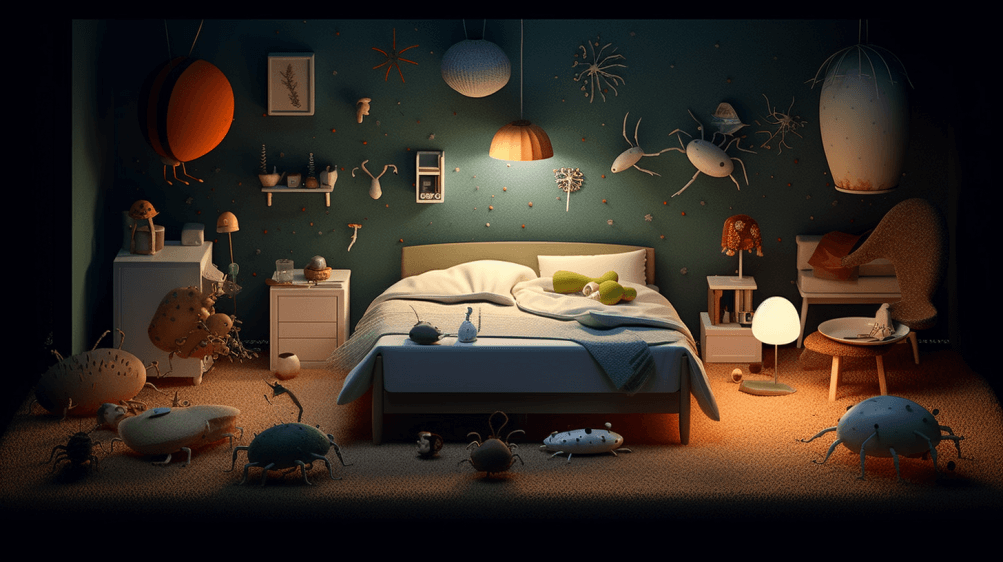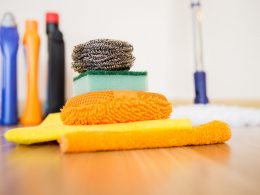Welcome to another informative post from Home Air Authority – your trusted resource for all things related to air quality. Today, we tackle a question that might have crossed your mind, a question often asked but seldom explained in clear terms: “Can you see dust mites?”
These tiny critters live in nearly every home, irrespective of how spotlessly clean you keep it. They’re infamous for triggering allergies, exacerbating asthma, and generally impacting indoor air quality. Yet, despite their pervasive presence, dust mites are shrouded in mystery. Many people have misconceptions about these creatures, confusing them with other household pests and even doubting their existence simply because they can’t see them.
In this blog post, we will unveil the truths about dust mites, dispel common misconceptions, and provide practical tips for managing them in your home. Our goal is to empower you with the knowledge to improve your home’s air quality and ensure a healthier living environment for you and your loved ones.
Read on to get a better understanding of these microscopic invaders and learn what you can do to control them effectively.
Understanding Dust Mites
Dust mites are microscopic creatures, a type of arachnid related to spiders and ticks. They are typically around 0.2-0.3 millimeters in size, which is why they are invisible to the naked eye. However, under a microscope, their appearance is similar to a white, eight-legged bug.
A crucial fact to understand about dust mites is their habitat preference. They thrive in warm, humid environments and are typically found in parts of your home where human skin cells— their primary food source—are abundant. This makes soft furnishings like mattresses, pillows, carpets, and upholstered furniture their favorite hangouts. However, they can also exist in other less obvious places, such as stuffed animals, curtains, and even clothes.
Despite their tiny size, dust mites can have a significant impact on human health. They do not bite or sting, but their body fragments and droppings can trigger allergic reactions in many people. Symptoms of dust mite allergy can include sneezing, runny nose, itching, watery eyes, and in severe cases, asthma attacks. The impact is often more pronounced in individuals who already have respiratory issues or are prone to allergies.
Now that we have a basic understanding of what dust mites are and how they live, let’s delve into the main topic—can you actually see these minuscule house guests?
Can You Actually See Dust Mites?
In short, the answer is no – you can’t see dust mites with the naked eye. They are simply too small. A dust mite measures approximately 0.2-0.3 millimeters. Thus, even if hundreds of dust mites were gathered in one place, they would still be nearly impossible to see without assistance.
To observe dust mites, one would typically need a microscope. Under magnification, dust mites appear as small, translucent creatures with eight legs, similar in appearance to a tiny spider. Some advanced digital microscopes or powerful magnifying lenses may allow you to spot them, but such equipment is not typically available in a standard household.
It’s important to remember that just because you can’t see dust mites doesn’t mean they aren’t present. They can be thriving in your home, especially in warm, humid environments with access to their favorite food—human skin cells. So rather than relying on visibility, it’s essential to control the conditions that favor their proliferation.
In the next section, we’ll dispel some common misconceptions about dust mites and further clarify the difference between these microscopic inhabitants and other common household pests.
Common Misconceptions About Dust Mites
Given the invisibility of dust mites, it’s no surprise that there are numerous misconceptions surrounding these microscopic creatures. Many people mistake them for bed bugs or other visible pests, leading to incorrect methods of dealing with them. Let’s debunk some of these common myths:
Myth 1: Dust Mites are Bed Bugs
This is perhaps the most common misconception. While both dust mites and bed bugs can inhabit your bedding, they are fundamentally different creatures. Bed bugs are parasitic insects that feed on human blood and can be seen with the naked eye. Dust mites, on the other hand, feed on skin flakes and are too small to see without magnification. Moreover, bed bugs can bite, causing red, itchy spots, while dust mites do not bite or sting.
Myth 2: You can get rid of Dust Mites entirely
It’s nearly impossible to eliminate dust mites entirely from your home. They’re a part of the natural environment and can easily be reintroduced into the home through open windows or on clothing. The key is to manage their population and reduce their impact on your health.
Myth 3: Dust Mites live in dirty homes
Dust mites can live in any home, regardless of how clean it is. They’re not attracted to dirt but to the skin flakes we constantly shed. Regular cleaning can help reduce the number of dust mites by removing these skin flakes, but it’s not a guarantee of a dust-mite-free home.
Understanding these misconceptions can help you deal with dust mites more effectively. Rather than aiming for an unrealistic goal of complete eradication, focusing on control measures can result in a healthier home environment. Up next, let’s delve into how the quality of air in your home impacts the dust mite population.
The Impact of Air Quality on Dust Mite Population
Air quality is a critical factor influencing the dust mite population in your home. Dust mites love environments that are warm and humid. Therefore, homes with poor ventilation, high humidity, or those situated in warmer climates often have higher dust mite populations.
Humidity
Dust mites absorb moisture from the air rather than drinking it. Hence, environments with high humidity levels (above 50%) provide the ideal conditions for dust mites to thrive. Conversely, when humidity levels drop below 50%, dust mites struggle to survive and reproduce, leading to a decrease in their population.
Temperature
Dust mites prefer warmer temperatures, generally between 68 to 77 degrees Fahrenheit (20 to 25 degrees Celsius). If the temperature in your home often falls outside this range, it could inhibit the growth of the dust mite population.
Air Circulation
Regular air circulation can help maintain low humidity levels, creating a less hospitable environment for dust mites. Poor air circulation, on the other hand, can lead to stagnant, moist air, providing a breeding ground for dust mites.
By managing these aspects of your indoor air quality, you can create conditions that are less favorable for dust mites, thereby controlling their population in your home. In the following section, we’ll provide strategies for effectively managing dust mites and improving your home’s air quality.
Managing Dust Mites in Your Home

Since dust mites are ubiquitous and nearly impossible to eliminate entirely, the best approach is to manage their numbers effectively. Here are some strategies to help you reduce the dust mite population in your home:
1. Regular and Thorough Cleaning
Regularly vacuuming carpets, rugs, and upholstered furniture can help remove dust mite allergens. Washing bedding, curtains, and other fabrics in hot water (at least 130 degrees Fahrenheit) can kill dust mites and remove their allergens.
2. Control Humidity Levels
Using a dehumidifier or air conditioner can help lower the humidity levels in your home, making the environment less hospitable for dust mites. Aim to keep indoor humidity below 50%.
3. Encase Mattresses and Pillows
Using allergen-proof covers on your mattresses and pillows can help reduce exposure to dust mites. These covers are designed with a tight weave that prevents dust mites from passing through.
4. Use HEPA Filters
High-efficiency particulate air (HEPA) filters can trap dust mite allergens and prevent them from being released back into the air. Look for vacuums and air purifiers equipped with HEPA filters.
5. Reduce Clutter
Clutter can provide more places for dust mites to hide and breed. Regularly decluttering can help reduce the number of spots dust mites can thrive in.
6. Limit the Use of Carpets
If possible, opt for hard flooring instead of carpets. Carpets can hold onto dust mite allergens and provide a favorable environment for dust mites.
While these methods can help, no single strategy is enough to manage dust mites effectively. It’s the combination of these measures that can help reduce dust mites’ impact on your health and improve your home’s air quality.
How To Manage the Dust Mite Population in Your Home
At Home Air Authority, we understand the importance of a dust-mite-free home for your health and comfort. We recommend a few products that can help manage the dust mite population in your living space:
1. Air Purifiers
Air purifiers equipped with HEPA filters can help remove dust mite allergens from the air. These devices trap and eliminate various particulates, including dust mite fragments and droppings, thus reducing allergen levels in your home.
2. Dehumidifiers
As we’ve mentioned, dust mites thrive in humid environments. A dehumidifier can help control your home’s humidity levels, making your living space less hospitable for dust mites.
Humidifiers
While dust mites favor high humidity, extremely dry air can also cause discomfort, particularly for those with respiratory issues or allergies. Good humidifiers allow you to strike a balance, maintaining humidity levels that discourage dust mites but still provide comfort for the household.
HVAC Filters
Regularly replacing the filters in your HVAC system can also contribute to reducing dust mite allergens in your home.
Remember, while each of these products can help, using them in combination with each other and the strategies we discussed earlier will give you the best results in managing dust mites. Now let’s wrap things up.
Conclusion
Dust mites are a fact of life in our homes. These microscopic creatures, invisible to the naked eye, can have a significant impact on your health, particularly if you or your loved ones suffer from allergies or respiratory issues. Understanding what dust mites are, where they live, and how they thrive is the first step toward managing their presence in your home.
By maintaining your home’s air quality, regularly cleaning, and using effective tools such as air purifiers, dehumidifiers, and HVAC filters, you can control the dust mite population. These steps can significantly reduce allergen levels, improve your indoor air quality, and ultimately, enhance your comfort and health at home.
Though we may not see them, dust mites are a reality we must acknowledge and manage. With the right knowledge and tools, we can make our homes less inviting to these microscopic house guests and more comfortable for us.
At Home Air Authority, we are committed to helping you achieve a healthier indoor environment. If you have further questions or need more information, feel free to reach out to us. Your journey to better indoor air quality starts here.
Frequently Asked Questions (FAQs)
1. Can I see dust mites without a microscope?
No, dust mites are microscopic creatures, measuring approximately 0.2-0.3 millimeters in size. They are invisible to the naked eye. You would need a microscope to see them.
2. Are dust mites harmful to humans?
Dust mites themselves are not harmful as they do not bite or sting. However, their body fragments and droppings can trigger allergic reactions in sensitive individuals, leading to symptoms such as sneezing, itching, watery eyes, and in severe cases, asthma attacks.
3. How can I reduce dust mites in my home?
You can reduce dust mites in your home by regular cleaning, controlling humidity levels, using allergen-proof covers on mattresses and pillows, using air purifiers with HEPA filters, reducing clutter, and limiting the use of carpets.
4. Do air purifiers help with dust mites?
Yes, air purifiers equipped with HEPA filters can help remove dust mite allergens from the air, thus helping to manage dust mite populations.
5. Does a dehumidifier kill dust mites?
While a dehumidifier doesn’t directly kill dust mites, it reduces the humidity level in your home, making it less hospitable for dust mites. Dust mites need a high humidity level to survive and reproduce. By keeping humidity levels below 50%, you can make it harder for dust mites to thrive.
6. Can dust mites live in all types of climates?
Dust mites prefer warm and humid environments. However, they can survive in various climates as long as they have access to their food source—human skin cells. That said, homes in warmer, more humid climates tend to have higher dust mite populations.
7. Is it possible to completely eliminate dust mites from my home?
It’s nearly impossible to eliminate dust mites entirely from your home. They can easily be reintroduced into the home through open windows or on clothing. Instead, focus on managing their numbers and reducing their impact on your health.










